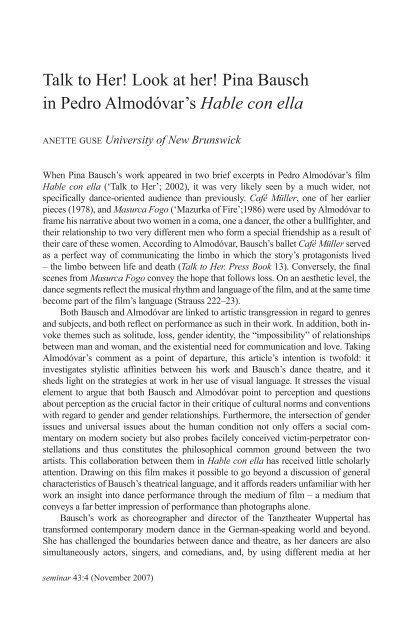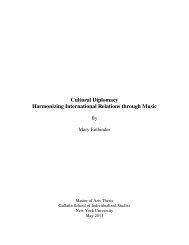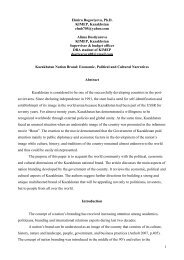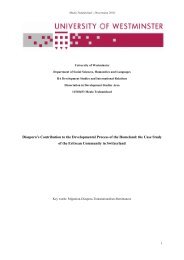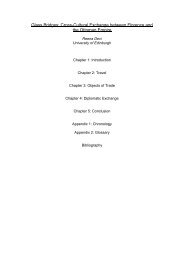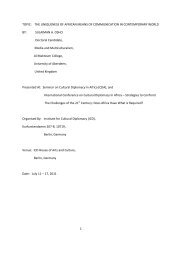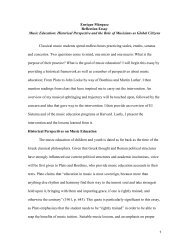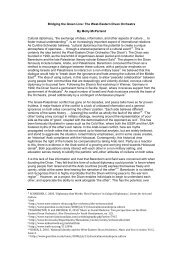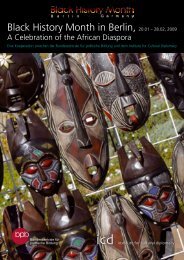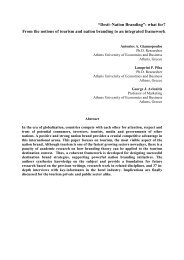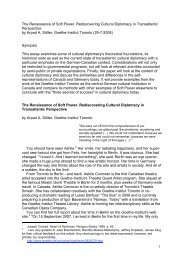Hable con ella - Institute for Cultural Diplomacy
Hable con ella - Institute for Cultural Diplomacy
Hable con ella - Institute for Cultural Diplomacy
Create successful ePaper yourself
Turn your PDF publications into a flip-book with our unique Google optimized e-Paper software.
Talk to Her! Look at her! Pina Bausch<br />
in Pedro Almodóvar’s <strong>Hable</strong> <strong>con</strong> <strong>ella</strong><br />
ANETTE GUSE University of New Brunswick<br />
When Pina Bausch’s work appeared in two brief excerpts in Pedro Almodóvar’s film<br />
<strong>Hable</strong> <strong>con</strong> <strong>ella</strong> (‘Talk to Her’; 2002), it was very likely seen by a much wider, not<br />
specifically dance-oriented audience than previously. Café Müller, one of her earlier<br />
pieces (1978), and Masurca Fogo (‘Mazurka of Fire’;1986) were used by Almodóvar to<br />
frame his narrative about two women in a coma, one a dancer, the other a bullfighter, and<br />
their relationship to two very different men who <strong>for</strong>m a special friendship as a result of<br />
their care of these women. According to Almodóvar, Bausch’s ballet Café Müller served<br />
as a perfect way of communicating the limbo in which the story’s protagonists lived<br />
– the limbo between life and death (Talk to Her. Press Book 13). Conversely, the final<br />
scenes from Masurca Fogo <strong>con</strong>vey the hope that follows loss. On an aesthetic level, the<br />
dance segments reflect the musical rhythm and language of the film, and at the same time<br />
become part of the film’s language (Strauss 222–23).<br />
Both Bausch and Almodóvar are linked to artistic transgression in regard to genres<br />
and subjects, and both reflect on per<strong>for</strong>mance as such in their work. In addition, both invoke<br />
themes such as solitude, loss, gender identity, the “impossibility” of relationships<br />
between man and woman, and the existential need <strong>for</strong> communication and love. Taking<br />
Almodóvar’s comment as a point of departure, this article’s intention is twofold: it<br />
investigates stylistic affinities between his work and Bausch’s dance theatre, and it<br />
sheds light on the strategies at work in her use of visual language. It stresses the visual<br />
element to argue that both Bausch and Almodóvar point to perception and questions<br />
about perception as the crucial factor in their critique of cultural norms and <strong>con</strong>ventions<br />
with regard to gender and gender relationships. Furthermore, the intersection of gender<br />
issues and universal issues about the human <strong>con</strong>dition not only offers a social commentary<br />
on modern society but also probes facilely <strong>con</strong>ceived victim-perpetrator <strong>con</strong>st<strong>ella</strong>tions<br />
and thus <strong>con</strong>stitutes the philosophical common ground between the two<br />
artists. This collaboration between them in <strong>Hable</strong> <strong>con</strong> <strong>ella</strong> has received little scholarly<br />
attention. Drawing on this film makes it possible to go beyond a discussion of general<br />
characteristics of Bausch’s theatrical language, and it af<strong>for</strong>ds readers unfamiliar with her<br />
work an insight into dance per<strong>for</strong>mance through the medium of film – a medium that<br />
<strong>con</strong>veys a far better impression of per<strong>for</strong>mance than photographs alone.<br />
Bausch’s work as choreographer and director of the Tanztheater Wuppertal has<br />
trans<strong>for</strong>med <strong>con</strong>temporary modern dance in the German-speaking world and beyond.<br />
She has challenged the boundaries between dance and theatre, as her dancers are also<br />
simultaneously actors, singers, and comedians, and, by using different media at her<br />
seminar 43:4 (November 2007)
428 ANETTE GUSE<br />
disposal, she has trans<strong>for</strong>med dance craft into a unique <strong>for</strong>m of visually strong per<strong>for</strong>mance<br />
art. She is internationally acclaimed by critics and dance practitioners, and she enjoys<br />
immense popularity with dance aficionados. She has become one of Germany’s most renowned<br />
modern cultural i<strong>con</strong>s. Now in the third decade of its existence, the Tanztheater<br />
Wuppertal boasts a repertoire of over thirty works. Each year the company produces a<br />
new work, frequently commissioned by public institutions <strong>for</strong> special occasions, and<br />
it <strong>con</strong>tinues to tour the world. With her creative selection of music, often drawing on<br />
world music, her signature choreography, and her inventive staging, Bausch has an undiminished<br />
power to impress, entertain, puzzle, provoke, and annoy. The subjects that<br />
she represents on stage – fear, loneliness, frustration, age, relationship between men and<br />
women, the exploitation of humans – all resonate with her audience.<br />
The sensual treatment of these themes through a fusion of various art <strong>for</strong>ms is reminiscent<br />
of “large-scale opera or ballet – theatre productions or even cinema,” as Ciane<br />
Fernandes aptly observes (5). One might even think of a “revue” when experiencing<br />
the sequence-character and visual glamour of pieces such as Masurca Fogo. Elements<br />
of theatre are apparent in the way the dancers sing and speak and wear costumes that<br />
are regular street-clothes rather than dance costumes. Carole Kew ascribes the effect<br />
of Bausch’s dance theatre to its theatrical gesture of grandeur and its sophisticated and<br />
innovative combinatory techniques:<br />
Is it the sheer spectacle that attracts? Everything about Pina’s work is big. Big subjects<br />
(love, anguish, struggle, loss). Big company (twenty-plus dancers). Big sets (based<br />
on nature with leaves, water, or earth). And her works are complex. Mixed media (in<br />
Danzon and Masurca Fogo). Many scenes (of montaged dance fragments and snatches<br />
of text). A collaged soundtrack (folk, classical). (5)<br />
The fundamental structure, however, is musical: Bausch makes use of melodies, leitmotifs,<br />
themes, counterthemes, repetitions, fugues and variations, and the result can be<br />
described as an optic symphony (Schmidt, “Nach Liebe suchend” 19).<br />
The massive literature about Bausch’s dance theatre, primarily but not exclusively<br />
written by dance scholars, views her work as a postmodern document reflecting the<br />
postmodern human <strong>con</strong>dition in terms of gender <strong>con</strong>struction, multiculturalism, and transnational<br />
culture. The analysis offered here examines her dance theatre as per<strong>for</strong>mance<br />
art and there<strong>for</strong>e primarily as a visual text. Its focus is on the theatrical language that she<br />
has developed throughout her œuvre. More specifically, it explores the nexus between<br />
the semiotics of the dancing body, the use of space, time, props and costume, music<br />
and multimedia, and choreographic patterns in order to elucidate the strategies at work<br />
in the text. However, the analysis of her presence in the work of Almodóvar requires<br />
an outline of the theoretical premises that in<strong>for</strong>m this study and a <strong>con</strong>textualization of<br />
existing scholarship on Bausch.<br />
While dance as a cultural phenomenon is frequently studied within the field of<br />
anthropology and historical dance research focusses on stylistic developments, periods,<br />
influential dancers, and choreographers, theoretical research on dance tends to centre on<br />
issues of movement and body-analysis. As a result of an emancipation from approaches<br />
that are based on aesthetic systems or dominated by literature, movement itself has become
Pina Bausch in Pedro Almodóvar’s <strong>Hable</strong> <strong>con</strong> <strong>ella</strong> 429<br />
the subject of discourse and is <strong>con</strong>sidered a multilayered text that not only is the object of<br />
analysis but also writes history itself (Jeschke 2–3). Recent approaches in dance research,<br />
led by Anglo-American academic discourse, have identified the body, movement, and<br />
dance as significant subjects of interdisciplinary studies (Balme 23). Further important<br />
impulses <strong>for</strong> research on dance theatre originated from the relatively young academic<br />
discipline of per<strong>for</strong>mance studies, which opened up the <strong>con</strong>cept of per<strong>for</strong>mance, including<br />
“any event, action, item or behaviour” (Schechner 10), as a possible subject of examination<br />
as per<strong>for</strong>mance, shifting the focus from meaning to function, from product to process,<br />
and interrogating anew the relationship between per<strong>for</strong>mance and hermeneutics. What is<br />
vitally important <strong>for</strong> this article’s reading of Bausch and Almodóvar is an understanding<br />
of the potential of per<strong>for</strong>mance: “Per<strong>for</strong>mances mark identities, bend and remake time,<br />
adorn and reshape the body, tell stories and allow people to play with behaviour that<br />
is ‘twice-behaved,’ not-<strong>for</strong>-the-first time, rehearsed, cooked, prepared” (Schechner 10–<br />
11). Per<strong>for</strong>mance studies has in fact maintained that, with the development of aesthetic<br />
per<strong>for</strong>mances (i.e. theatre, music, dance) in directions that blend genres – turning the<br />
per<strong>for</strong>mance into “per<strong>for</strong>mance art,” mixed media, “happenings,” or “intermedia” –<br />
the boundaries separating genres blur and that those separating art and life are broken<br />
through (Schechner 10–11). In a similar fashion, Erika Fischer-Lichte has expanded the<br />
understanding of what deserves our interest in studying per<strong>for</strong>mance. She emphasizes<br />
the importance of, and the curiosity <strong>for</strong>, examining the processes occurring during a production,<br />
a per<strong>for</strong>mance and the reception of a per<strong>for</strong>mance, and she argues <strong>for</strong> a more<br />
holistic view of “Produktions- und Rezeptions- bzw. Wirkungsästhetik”:<br />
[Eine] Ästhetik [des Per<strong>for</strong>mativen] fragt weniger nach den Bedeutungen, welche<br />
Darsteller und Publikum durch oder während einer Aufführung hervorbringen mögen;<br />
sie fokussiert vielmehr die per<strong>for</strong>mativen Prozesse des Herstellens, Verhandelns und<br />
Austauschens, die Darsteller und Zuschauer im Laufe der Aufführung vollziehen. (20)<br />
It is noteworthy that Fischer-Lichte’s <strong>con</strong>ception characterizes per<strong>for</strong>mance and the<br />
perception of per<strong>for</strong>mance as a dynamic, changing, and organic process. Akin to this<br />
view, and seeking to validate the specific generic qualities of dance with regard to the act<br />
of interpretation, the dance scholar Janet Adshead-Lansdale claims that the genre-specific<br />
transience and impermanence of dance needs to be viewed as a strength rather than a<br />
weakness. She rejects the idea of a “one-to-one correspondence between movement<br />
and meanings” and instead argues <strong>for</strong> interpretation as an “imaginative and intellectual<br />
process that associates movement and other elements of the dance with events and people,<br />
both within the movement/dance system and within wider artistic practices and cultural<br />
issues” (189). The inclusion of the broader cultural <strong>con</strong>text in the act of interpretation<br />
and the role of subjective “reading” by the viewer necessarily lead to the “multiplicity<br />
of possible narratives,” i.e. interpretations (189). As a <strong>con</strong>sequence, Adshead-Lansdale<br />
characterizes the “reader” (viewer) as the cocreator of a “mobile text” (dance) (203). This<br />
approach appears appropriate <strong>con</strong>sidering Bausch’s reluctance to be interpreted in any<br />
definite way, be it feminist or sociopolitical, and her much quoted statements about her<br />
work underscore this reluctance: “I just can’t say: ‘That’s how it goes [...]. I am watching
430 ANETTE GUSE<br />
myself. I am just as lost as all the others,’ or: ‘You can see it like this or like that. It just<br />
depends on the way you watch. But the single stranded thinking that they [the critics]<br />
interpret into it simply isn’t right. [...] You can always watch the other way” (Hoghe, “The<br />
Theatre of Pina Bausch” 72–73). For example, the female dancers in the plays often wear<br />
high heels, most of the time complementing a costume that <strong>con</strong>sists of elegant, feminine<br />
dresses, made from colourful, flowing, printed fabrics, that allude nostalgically to<br />
the style of the fashion in the thirties and <strong>for</strong>ties. The high heels could be interpreted<br />
as a symbol of cultural oppression <strong>for</strong>cing women to walk unnaturally, trans<strong>for</strong>ming<br />
them into sex objects. By having her dancers wear this footwear, she demonstrates how<br />
cultural aesthetic standards are inscribed and internalized, but the shoes – closed-toe<br />
shoes – are noticeably very elegant and thus fulfil an ambiguous function of feminization<br />
that cannot be narrowed down to sexual objectification. Bausch draws our attention to<br />
accepted <strong>con</strong>ventions by de<strong>con</strong>textualizing them, as, <strong>for</strong> example, when male dancers<br />
appear in cross-dressing costume, with high heels and female ball gowns, or in Masurca<br />
Fogo on stilts underneath a long dress. This reversal and exaggeration has an alienating<br />
and comical effect.<br />
A discussion of per<strong>for</strong>mance requires <strong>con</strong>sideration of further central components<br />
of the stage apart from the actor/dancer and his/her actions, notably the mise-en-scène,<br />
the arrangement of stage set and props, and the inclusion of media such as video film.<br />
Gabrielle Cody has described the effect of using real natural elements such as soil, water,<br />
and grass on stage as “bottled naturalism” (116). Examples of this occur in Bausch’s<br />
work: there are dead leaves covering the stage surface in Bluebeard (1977), a flooded<br />
stage in Arien (1979), a field of carnations bending in the wind in Tanzabend Nelken<br />
(1979), a <strong>con</strong>crete wall that crumbles on stage in Palermo, Palermo (1990), and two giant<br />
granite cliffs and the projected image of the ocean accompanied by the roaring sound<br />
of breaking waves in Masurca Fogo. The artificial, nondecorative presence of nature<br />
appears surreal, alienating, and, according to Bausch, simply aesthetically pleasing: “Ich<br />
finde das schön, so wirkliche Sachen auf der Bühne – Erde, Laub, Wasser” (Hoghe,<br />
Pina Bausch: Tanztheatergeschichten 34). This presentation of nature, however, clearly<br />
<strong>con</strong>trasts with the culture represented in the actions of the dancers, who, if not dancing<br />
solo, play short episodes that illustrate interactions between people. The appearance of<br />
animals on stage (portrayed by dancers) – <strong>for</strong> example a walrus in Masurca Fogo – has<br />
generally been interpreted as another surprise factor, possibly commenting on the human<br />
body’s entrapment (Cody 116). While many critics have discussed the aspect of cruelty<br />
of love – and, in particular, the violence portrayed against women – the role of humour,<br />
in the <strong>for</strong>m of verbal jokes, slapstick, or comical images, as well as the incorporation of<br />
children’s games in the depicted adult world, has thus far been neglected.<br />
The fact that so many things happen on stage simultaneously causes the spectator<br />
to feel overwhelmed at times or unsure about where to focus attention. Elizabeth Wright<br />
describes this as a “classic procedure in the postmodern per<strong>for</strong>ming arts. The spectator<br />
never feels sure that s/he is looking at the ‘right’ place, since the principal action always<br />
seems to go on off-centre. The ‘normal’ voyeuristic modes of sorting out the world are<br />
thus exposed and de<strong>con</strong>structed: the onlooker begins to feel the <strong>for</strong>ce of his/her own<br />
determining fantasies” (25). One factor that further <strong>con</strong>tributes to this sense of multiple
Pina Bausch in Pedro Almodóvar’s <strong>Hable</strong> <strong>con</strong> <strong>ella</strong> 431<br />
stories is Bausch’s technique of montage or collage without clear beginnings and endings<br />
– a technique that suggests infinite movement.<br />
One of Bausch’s artistic goals is to develop a type of language that achieves a level of<br />
communication beyond the common codes of ordinary verbal language. She is quoted as<br />
saying, “Mit dem ‘Nur Reden’ kann man ja nichts anfangen” (Hoghe, “Für Pina Bausch”<br />
13). The idea of dance as a type of language was articulated early on in the theory of<br />
modern dance, <strong>for</strong> example by Mary Wigman: “The dance is a living language which<br />
speaks of man – an artistic message soaring above the ground of reality in order to speak,<br />
on a higher level, in images and allegories of man’s innermost emotions and need <strong>for</strong><br />
communication” (10). Understanding dance as language and examining choreographies<br />
as texts presume acknowledgment of the fact that “interpretation is often difficult in<br />
dance, since movements, unlike words, have few combinatory rules that guarantee a<br />
clear, unambiguous communication of ideas. Dance is unlike verbal language, <strong>for</strong> it<br />
usually creates meaning only vaguely” (Banes 28).<br />
David Price has <strong>con</strong>vincingly argued that Bausch criticizes Western logocentrism in<br />
her theatre by using Artaud’s techniques, such as the subordination of speech and text,<br />
the importance of mise-en-scène, and the dreamlike quality of the stage (326–28). In the<br />
same vein, pointing to the theatricality of nonrepresentational, nonnarrative per<strong>for</strong>mance,<br />
bereft of unity and entered action, Wright seems to suggest that Bausch portrays the<br />
world as an absurd and dark place that leaves the individual unprotected:<br />
Clearly Bausch’s aim is not that of transmitting knowledge rationally. Her effects<br />
<strong>con</strong>tain no guide to interpretation via any programmatic texts, nor do her actors comport<br />
themselves with a <strong>con</strong>scious understanding of their role vis-a-vis one another. Stable<br />
selves disappear; intelligible <strong>con</strong>texts metamorphose unaccountably, <strong>for</strong>egrounding the<br />
vulnerability of the subject and its feeble defences. (25)<br />
Based on their indeterminacy and impermanence, it would appear as though images in<br />
dance scenarios are processed differently from language, appealing to different levels<br />
of perception that operate in a more intuitive, un<strong>con</strong>scious mode. The point of recognition<br />
(with the object, the gesture, the situation) is the crucial and definitive factor in<br />
appropriating the observed, and it is based on experience, familiarity, and knowledge<br />
– in this respect not unlike the vocabulary of language. In this way it becomes possible<br />
<strong>for</strong> the viewer to relate to what is per<strong>for</strong>med. Ursula Fritsch describes this process of<br />
understanding as resonance and emotional appropriation based on our physical memory.<br />
She refers to Bausch’s critical portrayal of culturally prescribed norms and rigid systems<br />
and <strong>con</strong>ventions of <strong>con</strong>trol and limitation that express themselves physically:<br />
Mit ihren Fragen spürt Pina Bausch die leiblich wirksamen gesellschaftlichen<br />
Zurichtungen und Eingrenzungen, die verinnerlichte “Selbstzwangsapparatur” (Elias)<br />
auf, sowie die darunter oder darüber liegenden Hoffungen und Sehnsüchte. [...] [S]oziale<br />
Modellierungen sind nicht mehr nur unbewusst im Tanz abgebildet [...] sondern werden<br />
selbst zur Erfahrung ausgestellt. Zuschauer können, soweit sie das Tanzgeschehen auf<br />
der Bühne an sich heranlassen, innerlich “mitschwingen,” empfinden und von daher<br />
begreifen, was in ihnen, in uns allen leiblich eingraviert ist. (271)
432 ANETTE GUSE<br />
If experience and familiarity are the foundation <strong>for</strong> understanding dance, the question<br />
arises as to how Bausch develops her choreography. Her method appears plausible:<br />
she taps into the dancers’ pool of memory by asking them to recall certain experiences<br />
and emotions or to imagine situations and to translate them into a gesture, movement,<br />
or short scene. Her point of departure is to work with the dancer as a whole person,<br />
drawing upon his or her imagination and creativity in the collective ef<strong>for</strong>t of approaching<br />
dance. The task or question challenges the dancer to use his or her body in a reflective<br />
and de<strong>con</strong>textualized, perhaps also playful manner beyond mere physical mastery of<br />
movement. Associations of this sort as well as movements and gestures of every day<br />
life produce material <strong>for</strong> the choreography that also may be inspired by places and cities<br />
(Fernandes 25–34; Hoffmann 12; Mulrooney 149–97; Schlicher 113–20, 139–45; Servos<br />
234–37; and Wildenhahn). This material is subsequently treated through the various<br />
factors of dance compositions such as<br />
energy, <strong>for</strong>m, space, and rhythm (Schlicher<br />
145).<br />
Through her method, Bausch has developed<br />
techniques and preferences that<br />
result in a unique vocabulary. Her techniques<br />
illustrate the blending of art <strong>for</strong>ms as well as<br />
the crucial role of “looking” and observing<br />
in her approach. One example of her choreographic<br />
strategies (see Fritsch 270–71), is<br />
her technique of <strong>con</strong>densing a story to a<br />
single word, image, or gesture. The effect<br />
could be either theatrical or, depending on<br />
the <strong>con</strong>text, also poetic. An example from<br />
Café Müller would be the gesture of the<br />
sleepwalking women with extended arms<br />
Café Müller<br />
reaching out into the space (see also Hoghe,<br />
Pina Bausch – Tanztheatergeschichten).<br />
Bausch also employs the cinematic techniques of slow motion and repetition in order to<br />
achieve emphasis or alienation. An example <strong>for</strong> the use of repetition can be taken from<br />
an eminent scene in Café Müller: the male dancer lifts a woman but fails to hold her on<br />
his arms just as she fails to cling onto him, thus slipping to the ground. This sequence<br />
is repeated excessively, thus suggesting despair and mutual torture. Another frequent<br />
technique is duplication, applied to a movement, either in the sense that everybody on<br />
stage carries out the same movement simultaneously, which clearly focusses the viewer’s<br />
attention on one centre of action, or in the sense that every dancer does his or her own<br />
typical movement at the same time, thus diverting the viewer’s attention to multiple<br />
centres of action. Bausch also engages in language games, de<strong>con</strong>structing language<br />
by drawing on idiomatic sayings that use the body in a metaphoric sense and has the<br />
dancers carry the saying out in a literal way – <strong>for</strong> example, “to pull someone’s leg,” is<br />
expressed in German by saying “to take somebody on your arm,” and this, then, is what<br />
the dancer would do. Contrast and transgression <strong>con</strong>stitute still another ploy, above all
Pina Bausch in Pedro Almodóvar’s <strong>Hable</strong> <strong>con</strong> <strong>ella</strong> 433<br />
as a prominent element in Bausch’s depiction of gender relationships: the proximity of<br />
tenderness and aggression, <strong>for</strong> example, is demonstrated with smiling couples whose<br />
loving touches upon each other’s hair turns into hair pulling, or whose kisses turn into<br />
aggressive bites. Finally, there is Bausch’s ironic play with gravity: movement often is<br />
not directed upwards but rather downwards, <strong>for</strong> example when dancers after a lift let<br />
themselves fall towards the ground. Likewise, the vertical plane is complemented by the<br />
horizontal plane – an earmark of modern dance. However, Bausch’s dancers are not only<br />
lying or sitting on the ground. Enabled through props such as water and rubber mats, they<br />
are sliding on the floor, thereby breaking the limitations of dance with what appears to be<br />
children’s games or circus acts.<br />
Bausch’s code of movement reflects a larger question of sociopolitical <strong>con</strong>ditioning<br />
of norms and ideals of movements and behaviour over the course of the history of<br />
civilization. Academic classical dance technique emerged during the time of French absolutism,<br />
and, with its artificiality, codified stylization, and regimentation, it symbolizes<br />
the restraint and <strong>con</strong>trol of human affects and passions. By <strong>con</strong>trast, early twentiethcentury<br />
modern dance liberated the language of the body and its movements by seeking<br />
emotional expressiveness. Based on the different purpose and aesthetics of dance, the<br />
function of the body changed, <strong>for</strong> no longer was it the ideal of dance to defy gravity<br />
and no longer was the ultimate goal the physical encapsulation of <strong>con</strong>trolled emotions.<br />
Ausdruckstanz was the dance of expression epitomized by the works of expressionist<br />
choreographers such as Rudolf Laban, Oskar Schlemmer, Mary Wigman, and Kurt Jooss<br />
during the 1920s (cf. Manning and Benson 30–35). Jooss latter was a mentor of Bausch<br />
at the Folkwang school in Essen, and it is safe to say that she reexplored this tradition of<br />
Ausdruckstanz in the late sixties and the seventies (Cody 117).<br />
Critics have commented on Bausch’s use of the body’s discursive potential and suggested<br />
that her <strong>con</strong>cept is rooted in social practice, viewing the body as representation<br />
of gender, race, and class (Birringer 86). Raimund Hoghe compares the body in her<br />
theatre to a landscape – vulnerable, open, marked by experience – that narrates stories<br />
without words, that speaks from individual and common histories (“Für Pina Bausch”<br />
12). Fernandes underscores that the interdependence of the body and society must be recognized:<br />
“the personal body is a social body – a social <strong>con</strong>struction at psychological and<br />
physical levels, <strong>con</strong>stantly permeated and <strong>con</strong>trolled by repetitive discipline within social<br />
power relationships” (9). Anne Fleig has coined the apt term “Körper-Inszenierungen”<br />
to illustrate the function of the body as central medium to <strong>con</strong>vey critical meaning:<br />
“Körper-Inszenierungen veranschaulichen, modizifizieren oder hinterfragen zentrale<br />
gesellschaftliche Wahrnehmungs- und Deutungsmuster wie Natur/Kultur, Männlichkeit/<br />
Weiblichkeit oder Realität/Fiktion” (13). In other words, rather than celebrating a cult of<br />
physical artistry and mastery as in <strong>for</strong>malist detachment, Bausch seems primarily interested<br />
in “talking” about and questioning culturally <strong>con</strong>ditioned <strong>con</strong>structions of established<br />
dichotomies, such as nature-civilization, masculinity-femininity, reality-fiction, childhoodage.<br />
In addition to this, by exploring and subverting the expectations and rules of dance,<br />
she ironically and playfully comments on the medium of dance itself.<br />
Bausch’s work is said to have influenced the aesthetics of both European and<br />
American choreographers and theatre directors, <strong>for</strong> example Robert Wilson, Anne
434 ANETTE GUSE<br />
Teresa De Keersmaeker, Bill T. Jones, and Peter Stein (Ross). Almodóvar expressed<br />
his admiration <strong>for</strong> the German choreographer in his first major breakthrough film Todo<br />
sobre mi madre (‘All About my Mother’), winner of the 1999 Oscar in the category of<br />
best <strong>for</strong>eign language film. In this film he paid homage to Bausch by including a poster<br />
of her in Café Müller in Cecilia Roth’s son’s room. In <strong>Hable</strong> <strong>con</strong> <strong>ella</strong> (2002) he included<br />
the a<strong>for</strong>ementioned two excerpts from her dance pieces. In addition, the central female<br />
character is a young ballet student who has decorated her room with pictures of her idol,<br />
Pina Bausch.<br />
Almodóvar is known <strong>for</strong> his treatment of <strong>con</strong>troversial subjects such as homosexuality,<br />
transsexuality, sadomasochism, drugs, rape, and incest, particularly in his early, mostly<br />
black-and-white films. Critics have also commented on his preference <strong>for</strong> melodrama,<br />
which, as he explains, allows him to “talk naturally about strong sentiments without a<br />
sense of the ridiculous” (Willoquet-Mari<strong>con</strong>di viii). Apart from these subversive themes<br />
and his critical insights into the social <strong>con</strong>struction of norms around gender and sexuality,<br />
his penchant <strong>for</strong> women and their stories is also of interest in this <strong>con</strong>text:<br />
When it comes time to write and direct, women attract me much more. I’ve always<br />
liked feminine sensitivity and when I create a character it’s much easier <strong>for</strong> me to do a<br />
feminine one, and I manage to shape it in a more solid and interesting way. On the other<br />
hand, women have more facets, they seem more like protagonist types. […] We, men,<br />
are cut from the same cloth, while women hold a greater mystery inside, they have more<br />
nuances and a sensitivity that is more authentic. (Willoquet-Mari<strong>con</strong>di x)<br />
The film begins where Todo sobre mi madre ended: the same theatre curtain of<br />
salmon-coloured roses and heavy gold fringing that had revealed a darkened stage in the<br />
earlier film now opens to reveal the Bausch spectacle Café Müller. In fact, Almodóvar<br />
credits Bausch, who appears in the Café Müller excerpt, together with Malou Airaudo,<br />
an original dancer from the Tanztheater Wuppertal, as providing both a starting point and<br />
a <strong>con</strong>clusion to <strong>Hable</strong> <strong>con</strong> <strong>ella</strong> through her works Café Müller and Masurca Fogo:<br />
When I finished writing “Talk to Her” and looked at Pina’s face again, with her eyes<br />
closed, and at how she was dressed in a flimsy slip, her arms and hands outstretched,<br />
surrounded by obstacles (wooden tables and chairs), I had no doubt that it was the image<br />
which best represented the limbo in which my story’s protagonists lived. Two women in<br />
a coma who, despite their apparent passivity, provoke the same solace, the same tension,<br />
passion, jealousy, desire and disillusion in men as if they were upright, eyes wide open<br />
and talking a mile a minute. (Talk to Her. Press Book 13)<br />
The per<strong>for</strong>mances of these two pieces are an integral part of the plot development, as<br />
they enable the encounter of the protagonists. Moreover, the dance segments frame the<br />
film and thus function as a poetic symbol <strong>for</strong> the themes of love, loss, communication,<br />
and friendship. Finally, they represent per<strong>for</strong>mativity and the act of watching, and both<br />
are clearly an important part of life and become prominent themes in their own right.<br />
The two main male characters of the film, Benigno and Marco, sit next to each other<br />
in the auditorium during a per<strong>for</strong>mance of Café Müller – the first chance encounter that<br />
leads to an unusual friendship between the two men. Two sleep-walking women wander
Pina Bausch in Pedro Almodóvar’s <strong>Hable</strong> <strong>con</strong> <strong>ella</strong> 435<br />
around in a reeling motion running into chairs and tables and against walls, while a man<br />
attempts to clear the way <strong>for</strong> them by pushing away the chairs and table. The atmosphere<br />
is one of chaotic loss. In the play there is no explanation <strong>for</strong> the state in which the women<br />
appear on stage – it is described only through portrayal. The accompanying music of<br />
this sequence underlines the sense of disorientation and sadness. It is the elegiac “O<br />
Let Me Weep, For Ever Weep” from Henry Purcell’s Fairy Queen (1698 and 1702),<br />
its words lamenting lost love. During the dance sequence, the camera cuts twice very<br />
briefly to the auditorium of the theatre and shows two male spectators in medium closeup.<br />
The se<strong>con</strong>d time, we realize that one of them (Marco) is weeping, moved to tears<br />
by emotion. After this dance sequence lasting about three minutes, the camera cuts to<br />
a shot in a hospital room, as is soon apparent from the blue nurse uni<strong>for</strong>m the younger<br />
man of the two (Benigno) is wearing. He tells Alicia, a patient not visible in the frame,<br />
that the per<strong>for</strong>mance he witnessed was so beautiful that this man cried. In the opening<br />
scene in the hospital that introduces Benigno’s relationship to Alicia, he presents to her<br />
an autographed photo by Bausch that the latter has signed with the words “I hope you<br />
overcome all your obstacles and start dancing!” This scene <strong>con</strong>taining this <strong>for</strong>eboding<br />
message can be <strong>con</strong>sidered part of the prologue of the dance sequence.<br />
In <strong>con</strong>trast to Café Müller, the later works appear less subjective and emphasize<br />
instead a global outlook and universality with a new thematic orientation towards cities<br />
and travelling, as is also evident in the selection of music (cf. Mulrooney). Masurca<br />
Fogo, the se<strong>con</strong>d piece incorporated into this film, was created <strong>for</strong> the Expo 98 in Lisbon<br />
and uses Portuguese fado, tango, samba, jazz, and pop songs. Apart from the appealing<br />
music, the inclusion of dialogues, film projections, outlandish costumes, and other visual<br />
effects and gags make <strong>for</strong> a stunning production, which enjoyed rave reviews in a recent<br />
tour in North America (Citron).<br />
The excerpt from Masurca Fogo that we see near the end of <strong>Hable</strong> <strong>con</strong> <strong>ella</strong><br />
opens with a midrange shot of the stage: we see a woman in a long flower dress,<br />
lying and being passed on the supporting hands of men who lie next to each other<br />
shoulder to shoulder with outstretched arms functioning like a human <strong>con</strong>veyer<br />
belt or, as the dance mistress excitingly explains to Alicia during the intermission,<br />
“like a wave” carrying the female dancer. All the while the woman breathes into a<br />
seventies style microphone, and her amplified sighs are a strange, disparate sound<br />
accompanied by k. d. lang’s song “Hain’t that funny,” which, with its line “It slowly<br />
dawned on me that my baby is bone<br />
/ My baby’s gone,” echoes the<br />
bereaved, lost-love mood of the<br />
Purcell passage. After being lifted<br />
to an extreme elevated and open<br />
position with arms stretched out to<br />
the side, she lets herself fall down in<br />
the waiting net of arms of the male<br />
dancers. The particular moment<br />
of the free falling <strong>for</strong>ward of the<br />
Masurca Fogo<br />
woman’s body is breathtakingly
436 ANETTE GUSE<br />
beautiful, <strong>for</strong> it displays complete openness and trust and the moment of catching<br />
the body represents a moment of perfect interplay between the woman and the men.<br />
The camera zooms in on the female dancer, tracking her movement and revealing<br />
her safe landing only at that very moment. Again, the theme of the song is that of<br />
loss, of alienation and sudden disillusionment, and the song enhances the emotion<br />
of mourning.<br />
The very last dance sequence shows an organized and oddly stylized pair dance,<br />
in which only a small sway of the hip and the lush stage setting of a bucolic idyll hints<br />
at its erotic nature. Yet it is unmistakably a sexually charged atmosphere. The couples<br />
dance in a very orderly manner in harmony to the sounds of an instrumentally upbeat<br />
Cabo Verde Mazurka (“Raquel,” by Bau) – until finally one couple breaks away from<br />
the <strong>for</strong>mation. Choosing this idyllic scene <strong>for</strong> the end of the film corresponds with the<br />
miraculous recovery of Alicia, the young dancer, and the allusion to the blossoming<br />
romance between her and Marco. Almodóvar elaborates in an interview the chosen scene<br />
from Masurca Fogo: “[It] begins with the sadness of the absent Benigno (the sighs) and<br />
unites the surviving couple (Marco and Alicia) through a shared bucolic emotion: [...]<br />
If I had asked <strong>for</strong> it specifically I couldn’t have got anything better. Pina Bausch had<br />
unknowingly created the best doors through which to enter and leave Talk to Her” (Talk<br />
to Her. Press Book 13).<br />
It is significant that both female protagonists in Almodóvar’s film are devoted to<br />
professions – dance and bullfight – that allow them physical challenge and artistic and<br />
emotional expression. Thus their physicality and bodies are placed in the <strong>for</strong>eground and<br />
remain so later, as they both become immobilized in comas. It is paradoxical that the two<br />
women in Almovódar’s film are extremely vulnerable and dependent on assistance and yet,<br />
at the same time, seem to exert power and <strong>con</strong>trol over the male (Yung). By comparison,<br />
in Bausch’s dance theatre, women are carried, twisted, and lifted, their bodies becoming<br />
objects of (playful) manipulation. Yet they seem to seek out that game, perpetuating it<br />
to the point of exhaustion. Her representation of gender relations has been commented<br />
on by numerous critics as depiction of the sadomasochistic terms of heterosexual power<br />
relations (Cody 120). It follows that the emotional range from joyfulness to obsession,<br />
from exuberance and pleasure to pain, desperation, and frustration is portrayed by both<br />
women and men in her dance theatre.<br />
A recurring phrase in the film occurs when the mistress of the dance (Geraldine<br />
Chaplin) comments to Marco after he reassures her of his harmless intentions towards<br />
Alicia: “I am a mistress of ballet – nothing is simple.” Because the complex nature of<br />
human relationships is the subject of dance and probably also because of her experience,<br />
she knows better than Marco and seems to disbelieve his naiveté. It is paradoxical that,<br />
during their ride to the bullfight in Madrid, Marco swears his love to Lydia and talks<br />
about how he has put his relationship with his separated wife behind him. By doing so,<br />
he distracts Lydia from telling him the truth about her return to her previous lover. Their<br />
relationship is marked by a lack of communication and, although he later tends to the<br />
comatose Lydia after she had been gored by the bull, he does not think of talking to her.<br />
In <strong>con</strong>trast to Marco, Benigno <strong>con</strong>tinuously talks to Alicia in order to cheer her up, telling<br />
her stories about his activities in her place such as going to the silent movies or to dance
Pina Bausch in Pedro Almodóvar’s <strong>Hable</strong> <strong>con</strong> <strong>ella</strong> 437<br />
per<strong>for</strong>mances. Benigno advises Marco to talk to Lydia as well, hence the title of the film.<br />
Originally, Almodóvar wanted to call his film “The Man Who Cried,” but Sally Potter<br />
had already taken this very title <strong>for</strong> her 2000 film starring John Turturro and Christina<br />
Ricci (Scott 163).<br />
Almodóvar points out that film is about “the joy of narration” and about “narrators”<br />
– “men who talk to whoever can hear them and above all to those who can’t” (Talk to<br />
Her. Press Book 7). Of no lesser importance in light of the metanarrative plane of the<br />
play is the thematization of the process of the <strong>con</strong>scious looking at, or more precisely, of<br />
the <strong>con</strong>scious viewing, of “per<strong>for</strong>mance.” Observing and watching occurs at different<br />
levels – one, at the level of narrative in the film and, two, at the level of its reception.<br />
In the narrative, it is routinely through a scenario of watching that the protagonists are<br />
brought together. As discussed above, the film starts out with the per<strong>for</strong>mance clip of<br />
Café Müller (with the first encounter between Benigno and Marco) and ends with the<br />
per<strong>for</strong>mance of Masurca Fogo in the same theatre (with the first encounter between<br />
Marco, Alicia, and her dance teacher). There are many more scenarios that underscore<br />
the importance of the act of watching: Marco sees Lydia the first time in a television<br />
talk-show, Benigno observes Alicia during her dance lessons from his apartment. At a<br />
garden party, Marco and Lydia watch the per<strong>for</strong>mance of a romantic song (“Cucurrucucú<br />
Paloma,” in a rendition by the Brazilian vocalist Caetano Veloso), and on the crucial day<br />
of Lydia’s final bullfight they watch a wedding ceremony together. Later Marco watches<br />
Lydia in the bullfight. In the hospital, he reencounters Benigno, watching him per<strong>for</strong>m<br />
his body-hygienic routine on Alicia, and it is the sight of Alicia’s naked breast that<br />
arouses his curiosity. After Benigno’s death he moves into his apartment and discovers<br />
the view into the dance studio, thus repeating Benigno’s voyeuristic observing as he recognizes<br />
Alicia exercising.<br />
As spectators of the film, we are of course watching throughout, but we are<br />
particularly drawn into the picture during point-of-view shots, when the camera<br />
perspective is identical with the perspective of the subject, and during close ups<br />
and camera angles that make us feel as if we were present at the same location.<br />
This is the case in the first hospital scene, where Benigno and another nurse wash<br />
and groom Alicia. Her body appears as if on display <strong>for</strong> the camera (Jones 15).<br />
Cinematographic care is taken in the shooting of the dressing scene of Lydia prior to<br />
the bullfight, with close-ups and tracking shots that follow every move of Lydia as<br />
she puts on and buttons up the brocade bolero-jacket and adjusts the fit of her tights<br />
of the bullfighting costume. The resulting effect of the camera work, in combination<br />
with warm glowing colours, is a very sensual one, as if the camera were caressing<br />
the body.<br />
Julian Smith has pointed out the sexual ambiguity of the character Lydia, played<br />
by the singer Rosario Flores, as a female bullfighter, which seems to resonate with<br />
the frequent cross-dressings in Bausch’s theatre (25). Most important as a showpiece<br />
of per<strong>for</strong>mance within the film, however, is the subsequent bullfight scene,<br />
which employs cinematographic techniques that Bausch has adopted from cinema<br />
– repetition and slow motion, the focus on one particular gesture of the torero (the<br />
turn as the bull passes, with erect posture, upper body extended back, and rotated,
438 ANETTE GUSE<br />
not unlike a dance posture). To highlight this scene, Almodóvar muffles the diegetic<br />
sound and overlays it with the nondiegetic music by Alberto Iglesias.<br />
If one wishes to read the film as reverence to women, their beauty, vulnerability, yet<br />
resilience and power, no other artist would have a perspective more akin to Almodóvar’s<br />
than does Bausch. Her Masurca Fogo introduces a strong image of life-affirmation in<br />
the final scene: a film of blossoming flowers is depicted in time-lapse, while couples,<br />
intimate and motionless, rest on the ground in <strong>for</strong>mations that resemble fetal positions<br />
or in the shape of yin and yang. While this scene could simply be read as an image of<br />
a sexual unity that is the basis <strong>for</strong> new life, an alternative reading would be to view it<br />
as the trans<strong>for</strong>mation of the two sexes into the original oneness. The idea of oneness or<br />
perfect communication is further substantiated by a film sequence that is screened in<br />
Masurca Fogo after the intermission and be<strong>for</strong>e the stage per<strong>for</strong>mance resumes. It is<br />
a documentary of a 1986 Cape Verde dance <strong>con</strong>test, and it depicts couples moving as<br />
dancing pairs in simple steps, but with great harmony. Close-ups of the feet and lower<br />
legs <strong>con</strong>vey the sense of perfect communication between the couples: the two dancers<br />
appear as a four-legged unity, the documentary thus a running commentary on what is depicted<br />
in the final image on stage and rein<strong>for</strong>cing the communication of a utopian ideal of<br />
human relationships. Even though her later pieces seem lighter in mood, more colourful,<br />
exotic, luxurious, and global, there is an underlying ephemeral quality to the happiness.<br />
The themes of noncommunication, of manipulation between men and women, the motif<br />
of desire and rejection, and the portrayal of absurdity and nonsense are embedded in an<br />
exuberant, sensual, and voluptuous texture of episodic pieces and images that range from<br />
“the <strong>con</strong>crete to the ephemeral, from the humorous to the horrid, from the satiric to the<br />
poignant” (Citron).<br />
Bausch weaves a multilayered text appealing to different channels of perception.<br />
The viewer is invited either to make intellectual <strong>con</strong>nections or to read the text intuitively<br />
or just to be entertained or amused. In many respects, the result is a mirror of the culture<br />
we live in. What we are shown is sometimes funny and sometimes bizarre. By turning to<br />
images of ethnic dance and nature in the <strong>for</strong>m of landscapes, ocean scenery, and blooming<br />
flowers, she projects visions that seem to <strong>con</strong>trast critically with the reality of Western<br />
culture and society. The route she takes is inquisitive, and the techniques of alienation<br />
and subversion trigger puzzling and unsettling effects. Ultimately, her strategies aim at<br />
heightening awareness of how things are and perhaps also at promoting a more accepting<br />
and <strong>for</strong>giving notion of human nature. By using a multitude of languages, her visual and<br />
kinetic per<strong>for</strong>mance art presents a superbly creative and powerful way of fully engaging<br />
both the intellect and the senses.<br />
What enabled the organic melting of Bausch’s dance theatre into Almodóvar’s film<br />
may be precisely the fact that both artists embrace the image, the visual and sensual,<br />
in ways that speak to faculties beyond the intellect, yet are supported by strategies that<br />
enhance critical awareness. These strategies strive to show and transgress limitations,<br />
norms, and <strong>con</strong>vention and, in <strong>con</strong>sequence, also venture into the surreal, the absurd,<br />
the childlike, or the power of nature. What is demonstrated, finally, is an understanding<br />
of per<strong>for</strong>mance and of witnessing per<strong>for</strong>mance that appears as a natural response to, or<br />
refuge from, reality – and is there<strong>for</strong>e an integral part of life itself.
Works Cited<br />
Pina Bausch in Pedro Almodóvar’s <strong>Hable</strong> <strong>con</strong> <strong>ella</strong> 439<br />
Adshead-Lansdale, Janet. “Narratives and Metanarratives in Dance Analysis.” Berghaus, ed.<br />
89–204.<br />
Almodóvar, Pedro, dir. <strong>Hable</strong> <strong>con</strong> <strong>ella</strong>. Screenplay Pedro Almodóvar. Perf. Javier Cámara,<br />
Rosario Flores, Dario Grandinetti, Leonor Watling. Warner Sogefilms. Spain 2002.<br />
———. Talk to Her. Press Book <br />
———. Todo sobre mi madre. Screenplay Pedro Almodóvar. Perf. Cecilia Roth, Eloy Azorin.<br />
Warner Sogefilms. Spain 1999.<br />
Balme, Christopher. Einführung in die Theaterwissenschaft. Berlin: Erich Schmidt, 2001.<br />
Banes, Sally. Writing Dancing in the Age of Postmodernism. Hanover: Wesleyan UP, 1994.<br />
Bau. “Raquel.” Talk to Her.<br />
Bausch, Pina. Tanztheater Wuppertal. 29 June 2007. .<br />
———, chor. and dir. Arien. Tanztheater Wuppertal. Premiere 12 May 1979.<br />
———, chor. and dir. Blaubart – Beim Anhören einer Tonbandaufnahme von Béla Bartoks<br />
Oper “Herzog Blaubarts Burg”: Szenen. Tanztheater Wuppertal. Premiere 8 Jan. 1977.<br />
———, chor. and dir. Café Müller. Tanztheater Wuppertal. Premiere 20 May 1978.<br />
———, chor. and dir. Masurca Fogo. Tanztheater Wuppertal. Premiere 14 April 1986.<br />
———, chor. and dir. Nelken. Tanztheater Wuppertal. Premiere 30 Dec. 1982.<br />
———, chor. and dir. Palermo. Palermo. Tanztheater Wuppertal. Premiere 17 Dec. 1989.<br />
Berghaus, Günter, ed. New Approaches to Theater Studies and Per<strong>for</strong>mance Analysis.<br />
Tübingen: Niemeyer, 2001.<br />
Birringer, Johannes. “Pina Bausch: Dancing Across Borders.” The Drama Review 30.2 (1986):<br />
85–97.<br />
Cody, Gabrielle. “Woman, Man, Dog, Tree: Two Decades of Intimate and Monumental Bodies<br />
in Pina Bausch’s Tanztheater.” The Drama Review 42.2 (1998): 115–31.<br />
Citron, Paula. “Bausch sets the beach on fire.” Review of Masurca Fogo. Pina Bausch’s<br />
Tanztheater Wuppertal at the National Arts Centre, Ottawa. Globe & Mail 29 November<br />
2004: R3.<br />
Erler, Detlef. Pina Bausch: Fotografien von Detlef Erler. Mit Texten von Heiner Müller,<br />
Raimund Hoghe, Norbert Servos und Jochen Schmidt. Zürich: Edition Stemmle, 1994.<br />
Fernandes, Ciane. Pina Bausch and the Wuppertal Dance Theater: The Aesthetics of Repetition<br />
and Trans<strong>for</strong>mation. New York: Lang, 2001.<br />
Fischer-Lichte, Erika. “Entgrenzungen des Körpers: Über das Verhältnis von Wirkungsästhetik<br />
und Körpertheorie.” Fischer-Lichte and Fleig, eds. 19–34.<br />
Fischer-Lichte, Erika, and Anne Fleig, eds. Körper-Inszenierungen: Präsenz und kultureller<br />
Wandel. Tübingen: Attempto, 2000.<br />
Fleig, Anne. “Körper-Inszenierungen: Begriff, Geschichte, kulturelle Praxis.” Fischer-Lichte<br />
and Fleig, eds. 7–18.<br />
Fritsch, Ursula. Tanz, Bewegungskultur, Gesellschaft: Verluste und Chancen symbolisch-<br />
expressiven Bewegens. Frankfurt/M.: Afra Verlag, 1988.<br />
Hoffmann, Eva. “Pina Bausch: Catching Intuitions on the Wing.” The New York Times 11<br />
Sept. 1994.<br />
Hoghe, Raimund. Pina Bausch – Tanztheatergeschichten. Mit Fotos von Ulli Weiss. Frankfurt/<br />
M.: Suhrkamp, 1986.<br />
———. “Für Pina Bausch.” Erler 12–13.<br />
———. “The Theatre of Pina Bausch.” The Drama Review 24.1 (1980): 63–74.<br />
Jeschke, Claudia. Tanz als Bewegungstext: Analysen zum Verhältnis von Tanztheater und<br />
Gesellschaftstanz (1910–1965). Tübingen: Niemeyer, 1999.
440 ANETTE GUSE<br />
Jones, Kent. “Pedro Almodóvar Creates Another Lush, Bittersweet Object of Beauty.” Film<br />
Comment 38.3 (2002): 15.<br />
Kaufmann, Ursula. Ursula Kaufmann fotografiert Pina Bausch und das Tanztheater Wuppertal.<br />
Wuppertal: Müller + Busmann, 2002.<br />
Kew, Carole. “Swimming with Pina.” Dance Theatre Journal 17.4 (2001): 4–7.<br />
lang, k. d. “Hain’t it funny.” Jane Siberry. Drag. Warner, 1997.<br />
Manning, Susan Allene, and Melissa Benson. “Interrupted Continuities: Modern Dance in<br />
Germany.” The Drama Review 30.2 (1986): 30–45.<br />
Mulrooney, Deirdre. Orientalism, Orientation, and the Nomadic Work of Pina Bausch.<br />
Frankfurt/M.: Lang, 2002.<br />
Price, David W. “The Politics of the Body: Pina Bausch’s Tanztheater.” Theater Journal 42.3<br />
(1990): 322–31.<br />
Purcell, Henry, comp. “The Plaint: O Let Me Weep, For Ever Weep.” Talk to Her.<br />
Ross, Janice. “Difficult Dances: The Choreography of Pina Bausch.” Stan<strong>for</strong>d Presidential<br />
Lectures and Symposia in the Humanities and Arts. 1999. Stan<strong>for</strong>d University. 27 June<br />
2007 .<br />
Schechner, Richard. “What is ‘Per<strong>for</strong>mance Studies’ Anyway?” Berghaus, ed. 1–12.<br />
Schlicher, Susanne. Tanztheater. Traditionen und Freiheiten. Pina Bausch, Gerhard Bohner,<br />
Reinhild Hoffmann, Hans Kresnik, Susanne Linke. Reinbek: Rowohlt Taschenbuch<br />
Verlag, 1987.<br />
Schmidt, Jochen. “Pina Bausch.” Introduction. Kaufmann, No pages.<br />
———. “Nach Liebe suchend auf dem Schlachtfeld des Lebens. Eine Annäherung an Pina<br />
Bausch.” Erler 16–20.<br />
Scott, A. O. “The Track of a Teardrop, a Filmmaker’s Path.” Pedro Almodóvar. Interviews. Ed.<br />
Paula Willoquet-Mari<strong>con</strong>di. Jackson: UP Mississippi, 2004 162–67.<br />
Servos, Norbert. Pina Bausch – Wuppertal Dance Theater or The Art of Training a Goldfish:<br />
Excursions into Dance. Tranls. by Patricia Stadié. Cologne: Ballett-Bühnen. 1984.<br />
Smith, Julian. “Only Connect.” Sight and Sound 12.7 (2002): 24–27.<br />
Strauss, Frédéric, ed. Almodóvar on Almodóvar. Transl. by Yves Baignères. London: Faber &<br />
Faber, 1996.<br />
Talk to Her. Soundtrack by Alberto Iglesias. Milan Records, 2002.<br />
Veloso, Caetano. “Cucurrucucú Paloma.” Talk to Her.<br />
Wigman, Mary. The Language of Dance. Trans. Walter Sorrell. Middletown, Connecticut:<br />
Wesleyan UP, 1966.<br />
Wildenhahn, Klaus, dir. Was tun Pina Bausch und ihre Tänzer in Wuppertal? Documentary,<br />
co-prod. NDR and WDR, Germany. Inter Nationes, 1983.<br />
Willoquet-Mari<strong>con</strong>di, Paula, “Introduction.” Willoquet-Mari<strong>con</strong>di, ed. vii–xv.<br />
———, ed. Pedro Almodóvar. Interviews. Jackson: UP Mississippi, 2004.<br />
Wright, Elizabeth. “The Production of Illusions: The Post-Freudian Theatre of Pina Bausch<br />
and Heiner Müller.” Assaph: Studies in the Theatre 7 (1991): 21–34.<br />
Yung, Susan. Review. “Bausch Meets Almodóvar in New Film.” 2002. 27 June 2007 .


